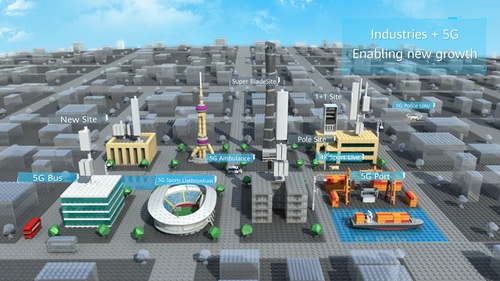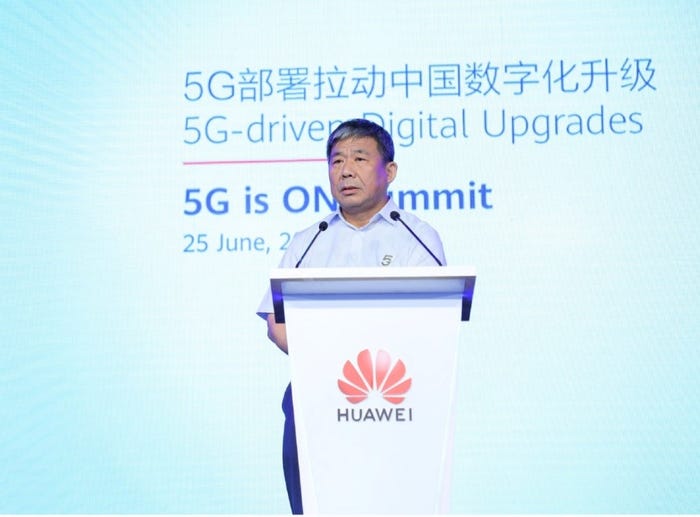August 5, 2019

This year’s MWC in Shanghai showed us how 5G is transforming a number of industries, including media, mining, healthcare, and electric power. In particular, the 5G unmanned mining excavator at the Huawei booth attracted considerable attention.
At 5G is ON Summit held on June 25, Li Degang, Vice President of Baogang Group and Chairman of Inner Mongolia Baotou Steel Union Co., Ltd, elaborated on Baogang Group’s 5G-supported intelligent mining project.
“Baogang Group is bringing its intelligent mining plan into reality with 5G,” said Li. “We are using 5G in many areas, including autonomous driving mining vehicles, UAV (unmanned aerial vehicle) mapping of geographic information, mine production scheduling and monitoring, and wireless data transmission.”

Li Degang, Vice President of Baogang Group and Chairman of Inner Mongolia Baotou Steel Union Co., Ltd
Baogang Group’s intelligent mining system
People of the communications industry might not be familiar with Baogang Group. Baogang Group was founded in 1954 as one of the 156 key projects in China’s First Five-Year Plan, and it started production in 1959. According to Li, over the past more than 60 years, Baogang Group has grown into the world’s largest rare earth industrial base, and also a steel industry base that provides plate steel, seamless steel pipes, steel rails, structural steel, construction steel, and more.
Baogang Group owns the Bayan Obo mine, which is 150 km from Baotou, the biggest city in Inner Mongolia. This mine is not only an iron mine, but also the world’s largest rare earth mine. Over the past 60 years, 400 million tons of ore have been produced here. The 48 km2 mining district has 1.56 billion tons of reserves.
Last year, Baogang Group built a new intelligent mining system at the Bayan Obo mine based on the latest information and automation technologies. This system consists of three integrated parts.
“The first part is driverless vehicles. Mining vehicles and equipment are major parts of an open-pit mine, and Baogang Group is piloting driverless vehicles and unmanned equipment operation,” explained Li. “The second part is the application of UAVs. UAVs can send back geographical mapping data to facilitate mine management. The third part is the production scheduling system based on the first two parts.”
Overall, Baogang Group’s intelligent mining project is an integrated application of technologies including driverless vehicles, UAVs, mine scheduling, 5G, and BeiDou/GPS navigation systems. Baogang Group is also working on developing an intelligent mining security system, effectively establishing security standards for using driverless vehicles in mining.
Li Degang elaborated on the three major parts of intelligent mining. In terms of autonomous driving, the first part, many companies are developing 5G autonomous driving technology. Autonomous driving for mining is simpler than it is for civil use, because the use cases at mines are less complicated. They use the same vehicle control technologies, such as the millimeter wave radar and video data monitoring. The problem to be solved is replacing human drivers with a 5G control system for driving mining vehicles.
In addition to mining vehicles, Baogang Group also owns a large number of loader trucks that need to be remotely controlled. As the outdoor temperatures in winter in the region often fall below –30°C, this remote control technology is a welcome improvement that allows drivers to work comfortably indoors. This is similar to autonomous driving.
The second core system is UAV mapping. Baogang Group uses UAVs for mapping, which send back geographical data for analysis. This way, mining locations, mining quantities, and explosive quantities for each day are no longer issues. Baogang Group also builds digital models for optimizing the management of mining processes. Baogang Group checks mine slopes with HD videos shot by UAVs to prevent landslide accidents. “This system also requires 5G data transmission,” said Li.
The third core system is the scheduling system. Baogang Group optimizes the entire scheduling system based on the data transmitted from the above two systems. “This is the very core of intelligent mining,” said Li. With these data, Baogang Group can find the best control methods and monitor the entire production process.
“5G is an absolute necessity for transmitting data between our core systems, because 5G features fast speed and high throughput,” said Li.
With 5G network ready, the first commercial 5G industrial control system will be built
Compared with civil vehicles, mining vehicles run in much simpler but also important scenarios. The cost of one mining vehicle can be CNY20 to 30 million. Each mining vehicle comes with tires of 2.5 to 3 meters in diameter. If a mining vehicle is not carefully controlled and moving at an appropriate speed while driving uphill in a narrow lane, it may tip over and roll down the slope. This will of course result in significant losses.
To support autonomous driving, regular cars require one or two on-board cameras, whereas mining vehicles need multiple cameras to cover 360 degrees and transmit data about vehicle conditions, road conditions, and so on. “The intelligent mining project has so much data to transmit, so 5G is a necessity for the intelligent mine project,” said Li. “It would be very hard to build an intelligent mine without 5G.”
Baogang Group kicked off the intelligent mining project last year, and by the end of April 2019, it had completed the 5G communications system for the mine. Prior to China’s Labor Day holiday in May, a 5G video call was made between leaders of the Inner Mongolia Autonomous Region and the mine staff to verify the system usability.
“With 5G, it is possible for technologies such as autonomous driving to be applied in the intelligent mine,” said Li. “We expect to be the first company in the industry sector to put the 5G system into commercial use this year.”
After applying 5G, Baogang Group is also planning to seek opportunities in intelligent manufacturing. According to Li, the evolving information technology has greatly transformed traditional industry and improved upon traditional work. Baogang Group is planning to build three platforms: first, a data cloud platform; second, a service management and control platform; and third, a decision analysis platform.
Baogang Group is also working on building an unmanned factory, improving its production and operation management system, and preparing to build an intelligent decision-making system. The unmanned factory will feature level-1 to level-3 automation, the production and operation system will feature level-4 automation, and the decision-making system will feature level-5 automation. Baogang Group plans to build a level-5 unmanned factory system based on 5G.
Key ideas: 5G will revolutionize the industrial control system
Li, who used to specialize in automation, has his own unique understanding of the value of 5G to the industrial sector. First of all, he predicts that the introduction of 5G, with its network latency lower than 20 ms, will revolutionize industrial control. Alternating current is the foundation of industrial control, and the period of alternating current is 20 ms. The application of 5G networks in industrial control will facilitate quick control of the system.
Second, as network speed accelerates, many industrial Internet use cases will change. As the industrial Internet places high demands on latency, many remote detection and remote control scenarios were only possible with wired networks. For example, industrial sites have a lot of moving equipment and rotating components, which are difficult to detect and control through wired networks. 5G overcomes this challenge, because detection and remote control data can be transmitted via mobile networks.
Lastly, professionals in 5G communications have been concerned with how 5G can help the industrial sector take a leading position. The answer is industrial Internet standards. Currently, the industrial sector has standards for wired Internet only. For example, Japan has created a lot of wired communication protocols for industry.
As companies like Huawei continue to forge ahead in 5G, standards in wireless communications systems will guide the industrial Internet. Such industrial Internet standards will be a big push for worldwide growth of technologies such as artificial intelligence and intelligent manufacturing.
Read more about:
Vendor SpotlightsAbout the Author(s)
You May Also Like









.png?width=300&auto=webp&quality=80&disable=upscale)


_1.jpg?width=300&auto=webp&quality=80&disable=upscale)


.png?width=800&auto=webp&quality=80&disable=upscale)